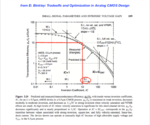momoke
Newbie level 3
How to find the strong inversion region of a mosfet? In th book, I find, wenn gm/Id is smaller than 10S/A, is it in strong inversion region.
Is it always the same for different process?
I have also read some paper and some write, when Vgs-Vth0>100mv it is in strong inverison region.
Please help.
Is it always the same for different process?
I have also read some paper and some write, when Vgs-Vth0>100mv it is in strong inverison region.
Please help.


